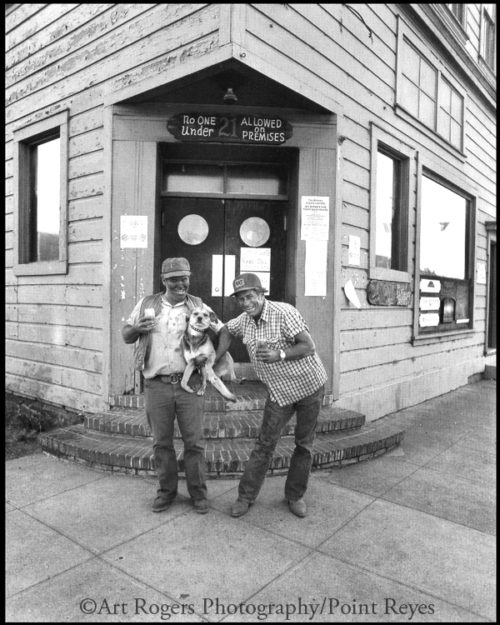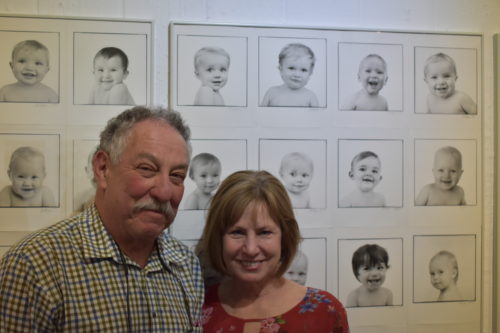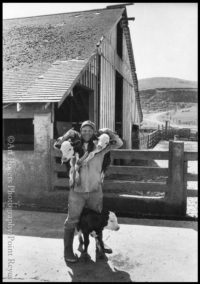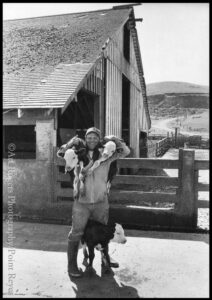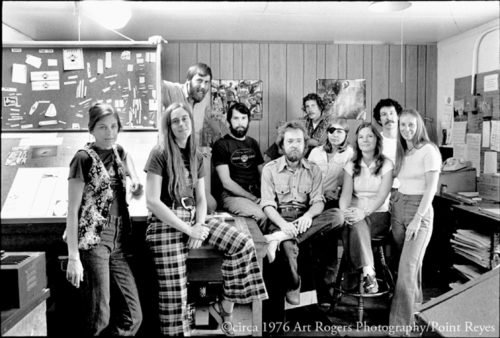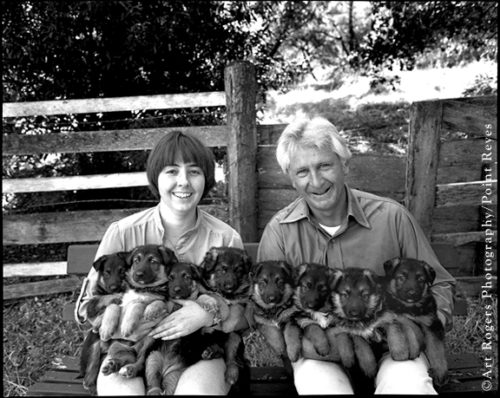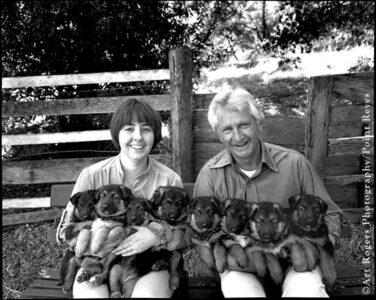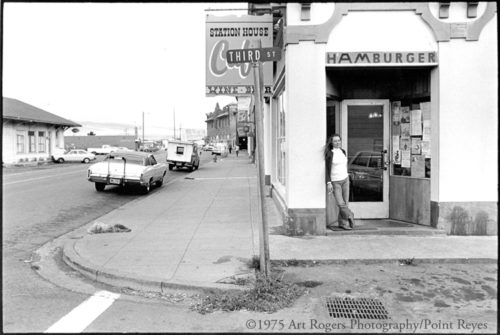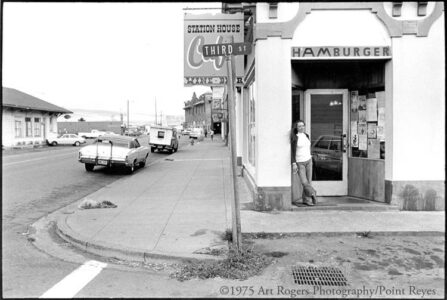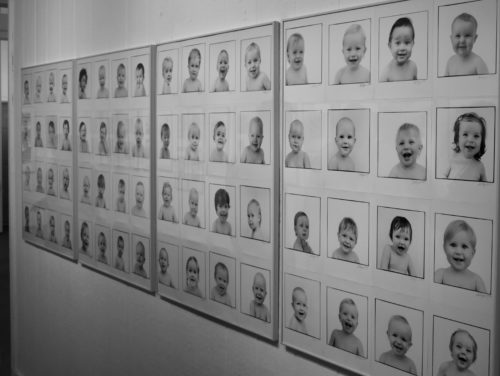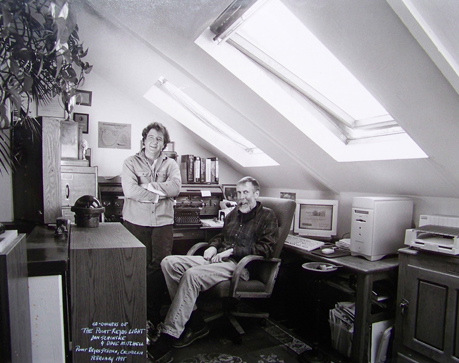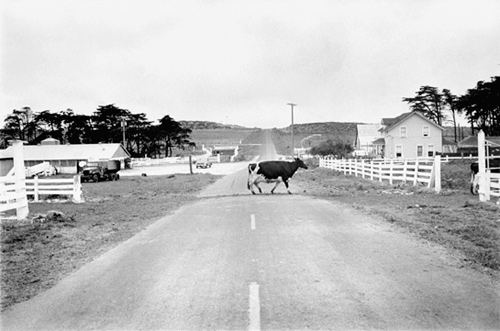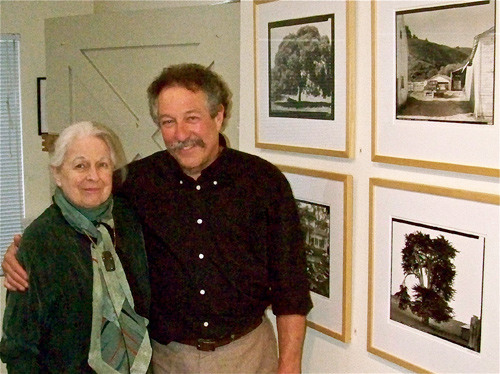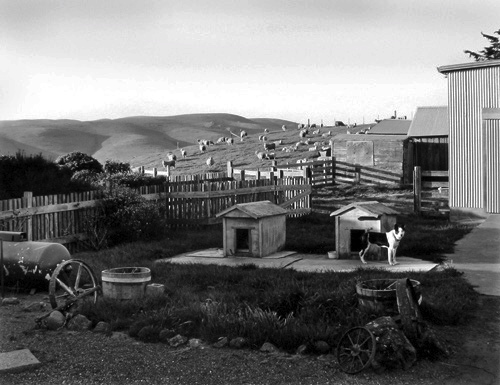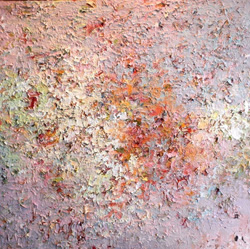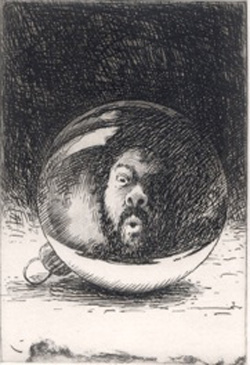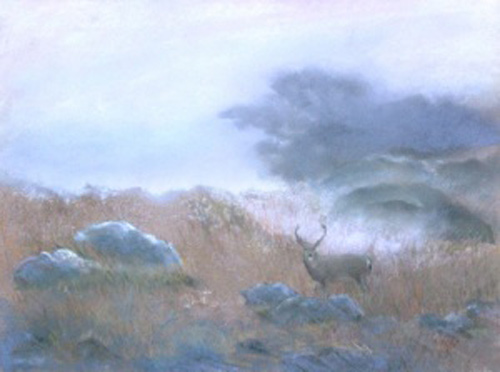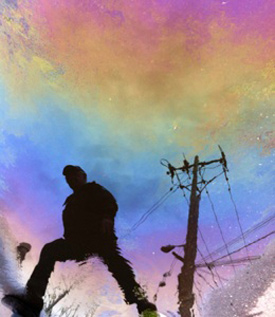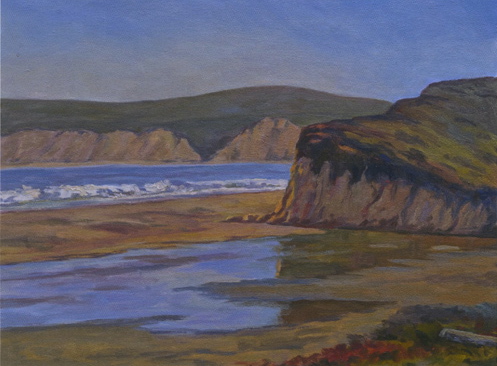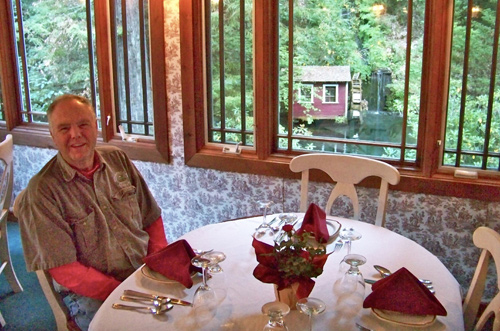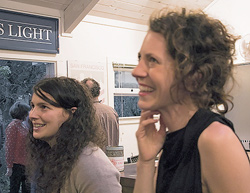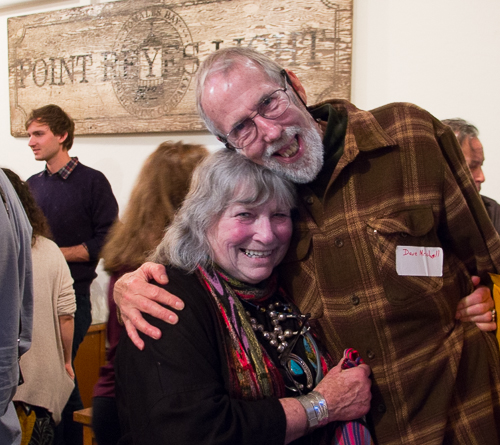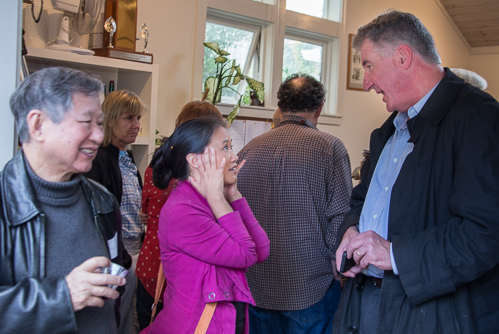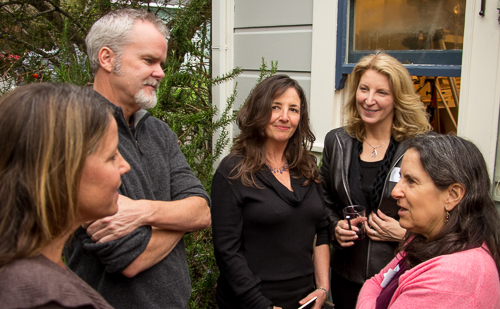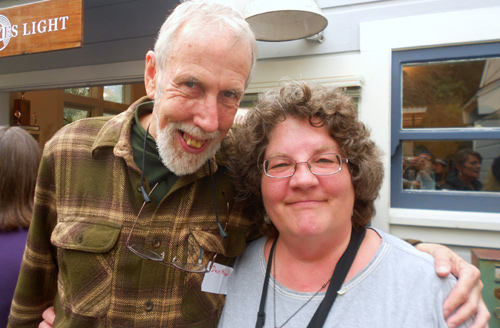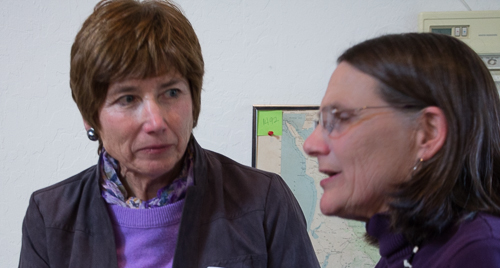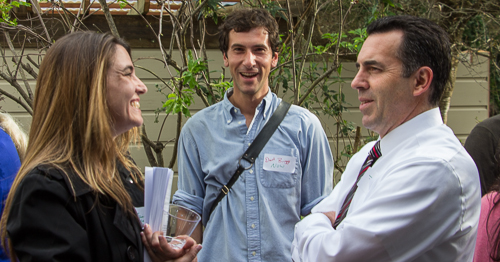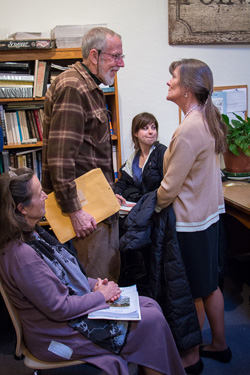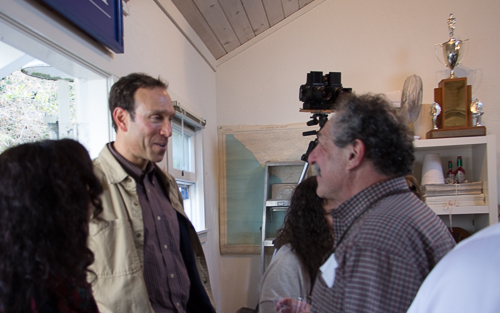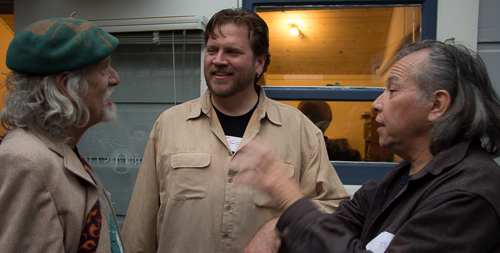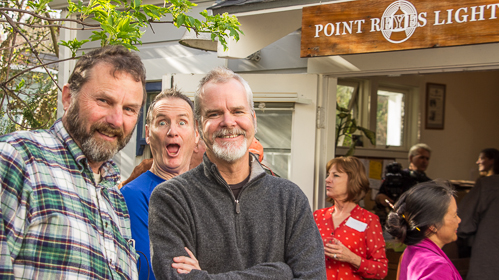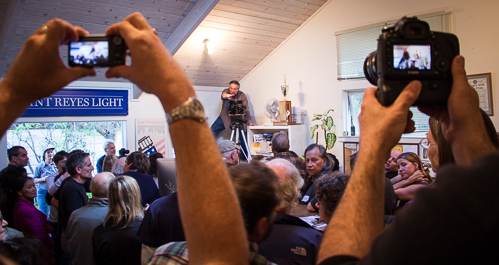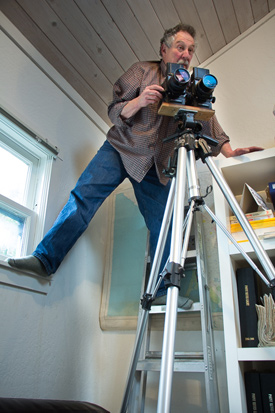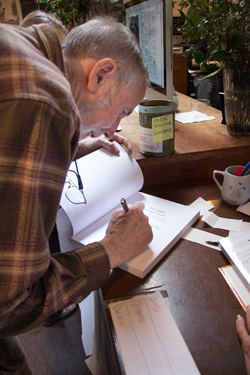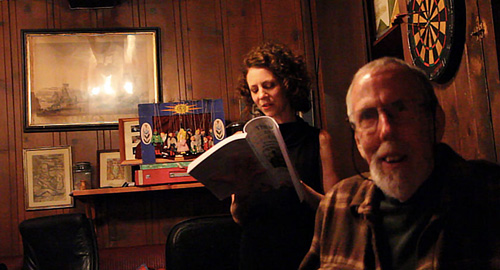Entries tagged with “Art Rogers”.
Did you find what you wanted?
Sat 23 Mar 2019
Caveat lectorem: When readers submit comments, they are asked if they want to receive an email alert with a link to new postings on this blog. A number of people have said they do. Thank you. The link is created the moment a posting goes online. Readers who find their way here through that link can see an updated version by simply clicking on the headline above the posting.
An impressive exhibition of Point Reyes Station photographer Art Rogers’ black-and-white portraits are on display until the end of April in the gallery at Toby’s Feed Barn. The display opened last weekend.
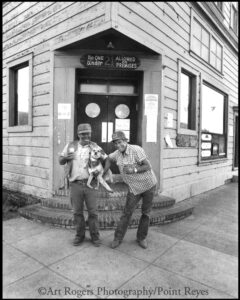

Bob Borello in the 1970s holding Stan Marsi’s dog, Buster, in front of the Western Saloon, which Bob owned. The two men, both now deceased, had just gotten off work at Bob’s rock quarry near Millerton Point, which accounts for their grime.
Art, as his website notes, “is widely known for his portraits of families, children and babies, large groups, and rural scenes and landscapes of West Marin. He is a recipient of a Guggenheim Fellowship and has also received fellowships from The National Endowment of the Arts and The Marin Arts Council and the SECA Art Award from the San Francisco Museum of Modern Art….

Art and his wife, Laura Rogers.
“His background includes stints as a baby photographer, a photojournalist and as a teacher at the San Francisco Art Institute and Indian Valley College. His photographs are included among the collections of the San Francisco Museum of Modern Art; the International Center of Photography, New York; the Center for Creative Photography Archive, Tucson; Le Musée de l’Elysée, Switzerland; and the de Young, San Francisco….
“He has produced a series entitled ‘Yesterday and Today’ in which the same subjects have been photographed in the same place after a time span of as much as 30 years….


A cow belonging to Point Reyes rancher George Nunes (pictured) produced triplets, which is very rare, one in a million births.
“He has documented the agricultural community on the North Coast for over 35 years….
“Rogers’ work has appeared in The Point Reyes Light for 45 years in his column titled “The Point Reyes Family Album.” It features a photograph every week of people and events in the community and is an ongoing historical documentation of these West Marin towns and villages.”
In addition, the Marin County Cultural Commission has named Art a Cultural Treasure of Marin.

The staff of The Point Reyes Light back when the newspaper was in the building now occupied by Coastal Marin Real Estate, Epicenter, and Rob Janes tax services. In 1984, The Light moved to the Old Creamery Building. It would later move again, this time to Inverness.


‘Puppies’
Art shot this portrait of Mary and Jim Scanlon of the San Geronimo Valley in 1980 only to have pop artist Jeff Koons produce a painted parody of it, which a court found to be a copyright violation. Koons settled a lawsuit with Rogers in 1986 for an undisclosed amount.
That same year Italian porno actress Ilona Staller, better known as Cicciolina, was elected to parliament in Italy and went on to marry Koons in 1991. The couple split up in 1994; to Koons’ chagrin, Cicciolina didn’t want to give up her porn career.


Restaurateur Pat Healy in 1975, four years after she bought the Station House Café. During the 1980s, Pat relocated the restaurant to the former Two Ball Inn building down the street. That bar had been owned by George and Shirley Ball, and their sign out front featured a No. 2 pool ball.

Art Rogers’ exhibition consists almost entirely of West Marin subject matter, several landscapes but mostly people, presented with affection. On just this wall there are 64 portraits of different West Marin babies.
Mon 23 Feb 2015
Posted by DavidMitchell under Point Reyes Station
1 Comment
Just over a year ago, Tomales Regional History Center published my second book (coauthored by Jacoba Charles) The Light on the Coast: 65 Years of News Big and Small as Reported in The Point Reyes Light. The third printing is almost sold out, and it may soon be time for a fourth.
To whet the appetite of those of you who haven’t yet picked up the book, here’s a column from it that was originally written 30 years ago when these ruminations were in print labeled “Sparsely Sage and Timely.” Back then, The Light was published in Point Reyes Station’s Old Creamery Building with the newsroom on the second floor.

The Light’s former newsroom with my partner Don Schinske standing and me sitting at my desk. Back then I wrote and edited text on a computer but wrote headlines on an old-fashioned, standard typewriter and then hand-carried them to the typesetter downstairs. © 1998 Art Rogers/Pt. Reyes, who contributed 10 photos to “The Light on the Coast.”
It’s late in the evening, and I’m sitting at a rolltop desk in the newsroom listening to a dog barking a block or two away. Every minute or so, I can hear a car come down Highway 1 into town and turn the corner by the bank. Once in awhile, a car heads up the hill, probably someone who just stopped in town for a drink before heading home.
When I first arrived in Point Reyes Station in 1975, I slept for a couple of months in the newsroom of the old Light building [across the street from today’s Whale of a Deli]. Despite being at a bend and intersection of a state highway, the spot was reasonably tranquil, at least after midnight. Oh, there’d be a brief flurry of shouting when the bars closed and the sound of unsteady feet scuffing past the window, but for a place to spend the night, a room on Point Reyes Station’s main street wasn’t that bad.
When I was in college and had yet to live in a small town, I chanced to read Winesburg, Ohio, Sherwood Anderson’s sketches of small-town life. In one of the tales, The Teacher, Anderson describes a late evening when there are only three people awake in Winesburg.
Naturally, one of the three was a reporter in the newsroom of the town’s weekly newspaper who pretended to be at work on the writing of a story. At last, the reporter too goes home and to bed. “Then he slept,” wrote Anderson, “and in all Winesburg, he was the last soul on that winter night to go to sleep.”
As a college student used to cities and suburbs, I found the concept of a town where no one was awake so strange that I briefly wondered if such a place were possible. Now, 20 years later, I find myself living in a town where on occasion late at night I probably am the only person downtown who isn’t asleep.
Of course, there are some nights when the tranquility of even this sleeping town is disturbed. A few years ago, Michael Jayson told me at the time, he had been asleep in an apartment over the old Dance Palace [where Cabaline is today] when he was awakened by the thunder of hooves below his window on Third Street.
A dog had gotten into rancher Waldo Giacomini’s pasture [now the Giacomini Wetlands] and began to worry a herd of cows, which then gave chase to the dog, crashing through a barbed-wire fence in their pursuit.
The next morning, Jayson told in amazement of having seen the stampede gallop up Third to Point Reyes Station’s main street and then turn east. At the T-intersection where the main street ends in front of Cheda’s Market, the herd wheeled around and headed back west.
As it happened, a fight had spilled out of the Western Saloon and into the intersection at Second Street where it had caught the eye of a bartender across main street at the Two Ball Inn [now the Station House Café. He called sheriff’s deputies, who had just arrived to break up the brawl when the stampede did it for them.
With a herd of cows galloping toward them, the two brawlers, along with onlookers, scattered. After the stampede had passed, however, the brawlers returned to the intersection only to have the stampede come through again on its second pass.
This time as the crowd dashed for safety, the two combatants kept on running, as did a number of Giacomini’s cows once the stampede reached the west end of main street. It was two days before the rancher got them all rounded up again. “I wish some people would keep their dogs tied up,” he grumbled to me afterward.
Down the street, the dog is barking again,probably bragging about the night when he alone provoked 50 head of Waldo Giacomini’s dairy cows to stampede through the middle of town. April 11, 1985
Sun 15 Jun 2014
Posted by DavidMitchell under Photography, Point Reyes National Seashore
Comments Off on Photography, drama, etchings, and paintings worth seeing this summer
I suggest you mark on your summer calendar four first-rate shows featuring people I know and admire. The venues will take you from Olema (or SFO) to Nicasio to Marshall to Cazadero.

Cow Crossing Spaletta Ranch. (Photo ©Art Rogers)
Point Reyes Station photographer Art Rogers held a well-attended opening reception Saturday in the Red Barn at Point Reyes National Seashore headquarters for an exhibition titled West Marin Views.
“For more than 150 years, photographic images have told the story of the American West and an era when life was simpler,” Art wrote in announcing the show. “They highlighted the beauty and tranquility of the western frontier and captured the intimate relationship of humanity with the land and animals. But it is not just a cultural memory, it is our American identity.
“I have lived and worked in West Marin as town photographer for over 43 years. These photographs are selections from this retrospect, of places that are beautiful, tranquil, dynamic, and that connect you to humanity, the land, and animals.”

Photographer Art Rogers with Stinson Beach gallery owner Claudia Chapline.
Since 1975, Art has provided The Point Reyes Light with weekly Point Reyes Family Album portraits of families, children and babies, large groups, rural scenes, and landscapes of West Marin. He is a recipient of a Guggenheim fellowship and has also received fellowships from the National Endowment for the Arts and the Marin Arts Council, as well as the Society for the Encouragement of Contemporary Art award from the San Francisco Museum of Modern Art.
His background includes stints as a baby photographer, a photojournalist and as a teacher at the San Francisco Art Institute and Indian Valley College. His photographs are included among the collections of the San Francisco Museum of Modern Art; the International Center of Photography, New York; the Center for Creative Photography Archive, Tucson; Le Musée de l’Elysee, Switzerland; and the de Young Museum, San Francisco.
He has produced a series titled Yesterday and Today, in which the same subjects have been photographed in the same place after a time span of as much as 30 years. His portraits have documented the agricultural community on the North Coast for more than 35 years.
Art’s exhibit in the park can be seen, by appointment only, through Aug. 5. People wishing to make an appointment need to contact Annalisa Price at 663-1200 (email bookstore@ptreyes.org) or Carola DeRooy at 464-5125 (email carola_derooy@nps.gov).

Ranch Dogs at Sunset, Tomales, 2006
Those who don’t want to go to the trouble of getting reservations for Art’s exhibit at park headquarters can drop by the San Francisco International Airport museum where he has a separate exhibit titled The Rustic Landscape showing until the end of August. The museum is in Terminal 3, Level 2. _____________________________________________________________________________________
 Art by the Bay Weekend Gallery is featuring works by Chuck Eckart of Point Reyes Station on weekends through July 27.
Art by the Bay Weekend Gallery is featuring works by Chuck Eckart of Point Reyes Station on weekends through July 27.
Also on display will be art by Nancy Stein, Jude Vasconcellos and Denis Bold.
Lynn and I were there when the exhibition was unveiled Saturday. The opening reception, however, will be held from 1 to 5 p.m. Sunday, June 22.
The gallery, which is located across Highway 1 from Tony’s Seafood restaurant is open from noon to 5 p.m Saturdays and Sundays.
This abstract painting is from Chuck’s Ground Cover series, which is rarely shown in West Marin.
“The Ground Cover paintings are abstractions and inventions taken from the natural environment surrounding Point Reyes and Alice’s garden,” according to a gallery announcement. (Chuck’s wife is named Alice.)
 San Francisco Chronicle art critic Kenneth Baker has written that “Eckart (left) locates, or brings into being a focal plane where we can dwell on the pleasure of seeing paint regain the materiality it sacrifices to subject matter in most figuration.
San Francisco Chronicle art critic Kenneth Baker has written that “Eckart (left) locates, or brings into being a focal plane where we can dwell on the pleasure of seeing paint regain the materiality it sacrifices to subject matter in most figuration.
“On the same plane we experience what anyone who knows painting will recognize as real expertise.”
Chuck himself adds, “Seeing paint, especially very thick, heavy paint being moved around by various tools I find very attractive to the eye.
“As the layers build up, the richer the visual experience becomes.
“It is my chief aim to attract the eye of the viewer and hold it as long as possible. It gets the viewer to see how the picture is made.
“Very seldom does this happen when viewing realist art.”
 In addition, Chuck will exhibit a hand-produced book, Midnight Ride, which consists of 30 etchings that were created as Christmas cards during the past 50 years.
In addition, Chuck will exhibit a hand-produced book, Midnight Ride, which consists of 30 etchings that were created as Christmas cards during the past 50 years.
This etching is titled Artist’s Reflection.
___________________________________________________________________________________

Apparition, one of Nancy Stein’s pastels, is also on display at Art By The Bay Weekend Gallery. ____________________________________________________________________________________
 Oil Slick Sky by photographer Jude Vasconcellos is part of the exhibit at Art By The Bay Weekend Gallery.
Oil Slick Sky by photographer Jude Vasconcellos is part of the exhibit at Art By The Bay Weekend Gallery.
____________________________________________________________________________________

Nicasio artist Thomas Wood will hold an opening reception from 1 to 4 p.m. Saturday, June 28, and from 1 to 4 p.m. Sunday, June 29, for an exhibition titled The Cliffs of Point Reyes. A closing reception will be held from 1 to 4 p.m. Saturday, July 5. His studio, Thomas Wood Fine Art, is located on Nicasio Square.

Cliffs at Drakes Bay
“To me,” writes Thomas, “the most striking features of the Point Reyes Peninsula are the cliffs above the shoreline of Drakes Bay, where the grassy pastoral hills terminate in sheer facades, their siltstone-sandstone geology revealed by the eternally sculpting wind and weather.
“In this series, I explore the cliffs’ shapes, textures, colors, lights and shadows, from different viewpoints, as they stand sentinel over the beach and surf.
“The work was largely completed on location. I like to paint directly from nature because, if successful, I achieve a freshness and immediacy obtained no other way.” ____________________________________________________________________________________

“Shakespeare in Cazadero? Mooo!” jokes Cazsonoma Inn owner Richard Mitchell (above), mimicking radio’s old commercial for Berkeley Farms milk. “No one believed there’d be ‘farms in Berkeley’ either.” The inn’s pond and waterfall can be seen out the window.
 The stately old redwoods around Cazsonoma Inn will be hosts this summer to the Bard’s great comedy, A Midsummer Night’s Dream.
The stately old redwoods around Cazsonoma Inn will be hosts this summer to the Bard’s great comedy, A Midsummer Night’s Dream.
“With Stanford cheerleaders and Berkeley scholars chasing each other over the streams and through the woods, into romantic bliss we go,” Richard writes.
“And no one knows the way like lovable, ‘puckish’ Kate Kennedy. Kate has been directing Shakespeare in and out of Sonoma’s vineyards for 35 years, and has assembled the Avalon Players, a talented troop of local actors to relive the ‘dream’ performed 400 years ago.
“Lush sets by Ross Heil, wacky costumes by FIDM’s Renée Brimm Mitchell, produced by Pezzo Unico Productions with Castles and Concerts, featuring ‘the magic flute’ of Matt Eakle, and sponsored by Boheme Wines, Flowers Winery, Paul Mathew Vineyards, Wild Hog Vineyards, “Estero Gold” cheese, Santa Fe Sausage Company, and River Road Olive Oil. The entire illusion portends to be a night to remember.”
The audience will move between the sculpture garden in front of the inn and the waterfall beside it for different acts.
Tickets and reservations at CazSonoma Inn are available at 707 632-5255 for June 25, 26, and 27 performances (5:30 p.m. sharp). A Saturday, June 28, matinee is already sold out. Along with the performances, the $75 tickets include hors d’oeuvres and wine before the show plus a four-course dinner afterward.
Tags: Art by the Bay Weekend Gallery, Art Rogers, CazSonoma Inn, Chuck Eckart, Denis Bold, Jude Vasconcellos, Midsummer Night's Dream, Nancy Stein, Richard Mitchell, Spaletta Ranch, Thomas Wood
Tue 4 Mar 2014
During an open house and reunion Saturday, a happy throng of Point Reyes Light readers, staff, and columnists joined with former staff and correspondents to celebrate the 66th anniversary of the newspaper’s first issue. 
The reunion drew staff and contributors who had worked at the paper at different times during the past 44 years. A number of former staff traveled hundreds of miles to attend. A couple of them arrived from out of state.
From left: Laura Lee Miller, David Rolland (who drove up from San Diego), Cat Cowles, Wendi Kallins, Janine Warner (who drove up from Los Angeles), Elisabeth Ptak (back to camera), Gayanne Enquist, Art Rogers (talking with Elisabeth), Keith Ervin (who drove down from Seattle), B.G. Buttemiller, and (in blue shirt with back to camera) Victor Reyes. (Photo by Dave LaFontaine) ______________________________________________________________
 The party was also a celebration of the Tomales Regional History Center’s publishing The Light on the Coast: 65 Years of News Big and Small as Reported in The Point Reyes Light.
The party was also a celebration of the Tomales Regional History Center’s publishing The Light on the Coast: 65 Years of News Big and Small as Reported in The Point Reyes Light.
Stuart Chapman of Bolinas, a former member of the staff, shot this photo, which he titled “Dave, Proud Father” because I authored the book.
My co-author was Jacoba Charles. Jacoba reported for The Light under its previous ownership and is a member of the paper’s board of directors under its present ownership, Marin Media Institute.
The colored Post-its, by the way, mark selections that I, along with others, would be reading to attendees. ____________________________________________________________

From left: Co-author Jacoba Charles, photographer Art Rogers, scientist Corey Goodman, photographer David Briggs, editorial consultant on the book and former member of The Light’s ad department Lynn Axelrod, and Spanish-language columnist Victor Reyes. (Except where noted otherwise, the photos in this posting were shot by former Light reporter Janine Warner)

Michael Gahagan (left), who drove down from the Sierra Nevada town of Columbia to attend, published The Light from 1970 to 1975. Here he reminisces with historian Dewey Livingston of Inverness. Dewey for many years provided a weekly historical feature titled “West Marin’s Past.”

During the Gahagan years, Lee Sims (left) was the newspaper’s main typographer. This was back in the days before offset printing, and each page that went on the press had to be composed in lead.
In a piece written for The Light’s 30th anniversary in 1978 and reprinted in The Light on the Coast, Michael Gahagan’s former wife Annabelle comments, “Poor Lee, he had the disadvantage of being a friend of ours. One can always depend on friends, and we did lean on him! He was always underpaid and overworked. (Weren’t we all?)”

Catching up on old times are (in foreground from left): former news editor David Rolland, who drove to the reunion from San Diego, former typesetter Cat Cowles of Inverness, and former reporter Joel Reese, who flew in from Chicago. Standing behind them are current reporter Christopher Peak (left) and Matt Gallagher, who filled in as managing editor from February through July 2011. _____________________________________________________________
 Samantha Kimmey (on the left) has been a reporter at The Light for the past year. With her is Tess Elliott of Inverness, who has been The Light’s editor for the past eight year. ____________________________________________________________
Samantha Kimmey (on the left) has been a reporter at The Light for the past year. With her is Tess Elliott of Inverness, who has been The Light’s editor for the past eight year. ____________________________________________________________

Gayanne Enquist was office manager during much of the 27 years I owned The Light. She was there when I arrived in July 1975, and she was there when I left in November 2005. (I was away reporting for the old San Francisco Examiner between September 1981 and the end of 1983.)

Former reporter Michelle Ling trades stories with Don Schinske, who was business manager during the 1990s and was co-publisher from 1995 to 1998. At left is her father, Dr. Walter Ling who teaches at UCLA. With his wife, May, Dr. Ling drove to Point Reyes Station for the celebration. In the background, Mary Papale listens intently to Laura Rogers.

Ingrid Noyes of Marshall (left) tells a story to my co-author, Jacoba Charles, outside The Light office.

Former staff recall the days of yore. From left: artist Laura Lee Miller, news editor David Rolland, typesetter Cat Cowles, reporter Janine Warner, and San Geronimo Valley correspondent Wendi Kallins. (Photo by Dave LaFontaine)

Sarah Rohrs was a reporter at The Light in the late 1980s. When several of us took turns reading aloud selections from The Light on the Coast, I read Sarah’s wonderfully droll account of a county fireman in Hicks Valley having to get a cow down out of a tree. (Photo by Joe Gramer)

Larken Bradley (left), who formerly wrote obituaries for The Light, chats with librarian Kerry Livingston, wife of Dewey.

Photographer Janine Dunn née Collins in 1995 traveled with news editor David Rolland to Switzerland’s Italian-speaking Canton of Ticino and to war-torn Croatia in doing research for The Light’s series on the five waves of historic immigration to West Marin. Here she chats with the paper’s current photographer David Briggs (center) and her husband John Dunn.

Former Light graphic artist Kathleen O’Neill (left) discusses newspapering in West Marin with present business manager Diana Cameron. _____________________________________________________________
 Former Light reporter Marian Schinske (right) and I wax nostalgic while photographic contributor Ilka Hartmann (left), looks on and Heather Mack (center), a graduate student in Journalism at UC Berkeley, takes notes. ____________________________________________________________
Former Light reporter Marian Schinske (right) and I wax nostalgic while photographic contributor Ilka Hartmann (left), looks on and Heather Mack (center), a graduate student in Journalism at UC Berkeley, takes notes. ____________________________________________________________

Former news editor Jim Kravets (left) jokes with photographer Art Rogers.

John Hulls of Point Reyes Station and Cynthia Clark of Novato have in the past worked with The Light in various capacities. In 1984, Cynthia set up the first computer system for the newsroom and ad department.

From left: Stuart Chapman of Bolinas, who formerly worked in The Light’s ad department, swaps stories with journalist Dave LaFontaine of Los Angeles and Light columnist Victor Reyes.

Historian Dewey Livingston (left), a former production manager at The Light, poses with former news editor David Rolland while former business manager Bert Crews of Tomales mugs in the background.

In preparing to shoot one of his signature group portraits, Art Rogers directs members of the crowd where to stand. With the throng crowded into the newspaper office, getting everyone in the right place to be seen was such a complicated operation that some of the photographer’s subjects began photographing him. _____________________________________________________________
 In shooting a series of three-dimensional photos, Art had to use a tall tripod and balance precariously on a window ledge and ladder. _____________________________________________________________
In shooting a series of three-dimensional photos, Art had to use a tall tripod and balance precariously on a window ledge and ladder. _____________________________________________________________

Art’s wife, Laura, who didn’t have to work nearly as hard, pages through a copy of The Light on the Coast. _______________________________________________________________
 The party was in part a book-signing, and I signed copies off and on all afternoon. ______________________________________________________
The party was in part a book-signing, and I signed copies off and on all afternoon. ______________________________________________________

Light editor Tess Elliott reads Wilma Van Peer’s 1998 account of working for the paper’s founders, Dave and Wilma Rogers half a century earlier. The newspaper was called The Baywood Press when it began publishing in 1948. The paper’s fourth publisher, Don DeWolfe, changed the name to Point Reyes Light in 1966.
Originally the readings were scheduled to be held in the newspaper office, but so much socializing was going on they had to be delayed until the party moved around the corner to Vladimir’s Czech Restaurant where the banquet room had been reserved.
Among those reading besides Tess were Dewey Livingston, David Rolland, Matt Gallagher, and I. Anyone wishing to watch me read former publisher (1957 to 1970) Don DeWolfe’s account of his initiation to running the paper can click here.
It was a grand party, and I want to thank present Light staff, who made arrangements for the party, and former staff, some of whom traveled significant distances to attend the reunion.
Two other book readings are also scheduled. At 3 p.m. Sunday, March 9, in Point Reyes Presbyterian Church, Point Reyes Books will sponsor readings from The Light on the Coast and from Point Reyes Sheriff’s Calls, Susanna Solomon’s book of short stories inspired by Sheriff’s Calls in The Light.
At 4 p.m. Sunday, April 27, in its Corte Madera store, Book Passage will sponsor readings from The Light on the Coast. Refreshments will be served.
Tags: Art Rogers, B.G. Buttemiller, Baywood Press, Bert Crews, Cat Cowles, Christopher Peak, Corey Goodman, Cynthia Clark, Dave LaFontaine, Dave Rogers, David Briggs, David Rolland, Dewey Livingston, Diana Cameron, Don DeWolfe, Don Schinske, Elisabeth Ptak, Gayanne Enquist, Heather Merk, Ilka Hartmann, Jacoba Charles, Janine Dunn née Collins, Janine Warner, Jim Kravetz, John Dunn, John Hulls, Kathleen O'Neill, Keith Ervin, Kerry Livingston, Larken Bradley, Laura Lee Miller, Laura Rogers, Lee Sims, Marian Schinske, Matt Gallagher, Michael Gahagan, Point Reyes Light, Sarah Rohrs, Stuart Chapman, Tess Elliott, The Light on the Coast, VÃctor Reyes, Wendi Kallins
Sun 23 Oct 2011
Posted by DavidMitchell under General News, Point Reyes Station
Comments Off on Occupy Wall Street protest expands to Point Reyes Station
Approximately 65 people showed up Sunday morning in West Marin School’s parking lot to take part in the Occupy Wall Street movement, which began Sept. 17 in New York City and since then has spread around the world.
As of two weeks ago, there had been protests in 70 major US cities and more than 600 smaller communities. There had also been protests in more than 900 foreign cities. A Time magazine survey earlier this month found that 54 percent of Americans have a favorable impression of Occupy Wall Street while 18 percent do not.
The movement is in essence a protest against the unequal distribution of wealth in the United States and elsewhere. In this country, the protesters’ slogan “We are the 99 percent” refers to the disparity in wealth between the top one percent of society and other citizens.
The phrase came out of the 2000 presidential candidate debates between Al Gore and George W. Bush. Gore repeatedly accused Bush of supporting the “wealthiest one percent” rather than the welfare of everyone else. That was followed by a 2006 documentary film, The One Percent, made by Johnson & Johnson heir Jamie Johnson. The film noted that the wealthiest one percent of Americans then controlled 38 percent of the nation’s wealth.
Already this country’s disparity in wealth was well known. In 2001, Joseph Stiglitz, a Nobel winner in economics, had written that the wealthiest one percent of US citizens at that time controlled 40 percent of America’s wealth.
 Among those assembling to be photographed at West Marin School was Congressional candidate Norman Solomon (in blue shirt). Sunday’s protest lasted less than half an hour and caused no disruptions.
Among those assembling to be photographed at West Marin School was Congressional candidate Norman Solomon (in blue shirt). Sunday’s protest lasted less than half an hour and caused no disruptions.
Because Occupy Wall Street has no list of specific demands, only that income should be spread more evenly and that large corporations should have less influence over government policies, some politicians and mainstream media have dismissed it as irrelevant.
House Majority Leader Eric Cantor (R-Va) characterized the movement as “growing mobs” and said President Barack Obama’s “failed policies” have pitted “Americans against Americans,” leading to the protests. White House press secretary Jay Carney then accused Cantor of “hypocrisy” since Cantor has been supporting Tea Party protests. “I can’t understand how one man’s mob is another man’s democracy,” Carney said.
The protests are coming at a time when millions of Americans have lost their homes and many millions more have lost their jobs largely because of big banks’ risky lending, which triggered a stock-market crash that has led to a recession.
Many congressional Democrats, including House Minority Leader Nancy Pelosi, have said they support Occupy Wall Street. In contrast, several high-profile Republicans have denounced it. Presidential candidate Herman Cain, a former banker and pizza chain owner, called the protests “anti-capitalist…. Don’t blame Wall Street, don’t blame the big banks if you don’t have a job and you’re not rich,” he said. “Blame yourself!”
Candidate Ron Paul, however, shot back, “The system has been biased against the middle class and the poor…the people losing jobs. It wasn’t their fault that we’ve followed a deeply flawed economic system.”

Point Reyes Station photographer Art Rogers, who currently has an exhibition at the Jack Mason Museum of West Marin History, documented the event. Here he directs protesters to find spots where his camera can record everyone’s face.
Giving support to the protests have been a number of labor unions and even several well-off people whose wealth puts them in the upper one percent. Leah Hunt-Hendrix, 28, granddaughter of the conservative, Texas oil tycoon H.L. Hunt, earlier joined Occupy Wall Street protesters and said, “We should acknowledge our privilege and claim the responsibilities that come with it.”
Federal Reserve chairman Ben Bernanke observed: “People are quite unhappy with the state of the economy and what’s happening. They blame, with some justification, the problems in the financial sector for getting us into this mess, and they’re dissatisfied with the policy response here in Washington. And at some level, I can’t blame them.”
Bank of Canada governor Mark Carney was more emphatic, saying income inequality and economic performance are the main motivators for the protests, which he called “entirely constructive.”
As it happens, Occupy Wall Street is the brainchild of Canada’s Adbusters Media Foundation, which publishes an advertisement-free, anti-consumerist magazine Adbusters. The foundation last summer proposed a peaceful occupation of Wall Street to protest corporate influence on democracy. By now Canada itself has had protests in all 10 of its provinces.
In this country, Vikram Pandit, head of Citigroup, has called the protesters’ sentiments “completely understandable” and said Wall Street has broken the trust of its clients.
Conservative Republicans have called the protests “class warfare,” but Bill Gross, manager of PIMCO’s Total Return Fund, the world’s largest mutual fund, disagreed. “Class warfare by the 99 percent?” he asked. “Of course, they’re fighting back after 30 years of being shot at.” PIMCO’s co-CEO Mohamed El-Erian concurred that people should “listen to Occupy Wall Street.”
Bloomberg news service on Oct. 12 reported, “Hedge-fund manager John Paulson, who became a billionaire by betting against the US housing market and then profited from the recovery of banks, criticized the movement. His townhouse was among those targeted by marchers who left a fake tax-refund check made out for $5 billion on his doorstep, which was barricaded by police.
“Paulson & Co. and its employees have paid hundreds of millions in New York City and New York State taxes in recent years and have created over 100 high paying jobs in New York City since its formation [in 1994],’ the $30 billion hedge fund said yesterday in a statement. ‘Instead of vilifying our most successful businesses, we should be supporting them and encouraging them to remain in New York City and continue to grow.'”
Regardless of New York tax rates, the Occupy Wall Street movement by Sunday had spread 2,580 miles from that metropolis on the East Coast to this small town on the West Coast.
Only in Point Reyes Station, there was no Zuccotti Park where sometimes-animated protesters have been camping out near Wall Street. Here there was just a brief get-together in the parking lot of West Marin School where 65 residents stood absolutely still to be photographed protesting.

